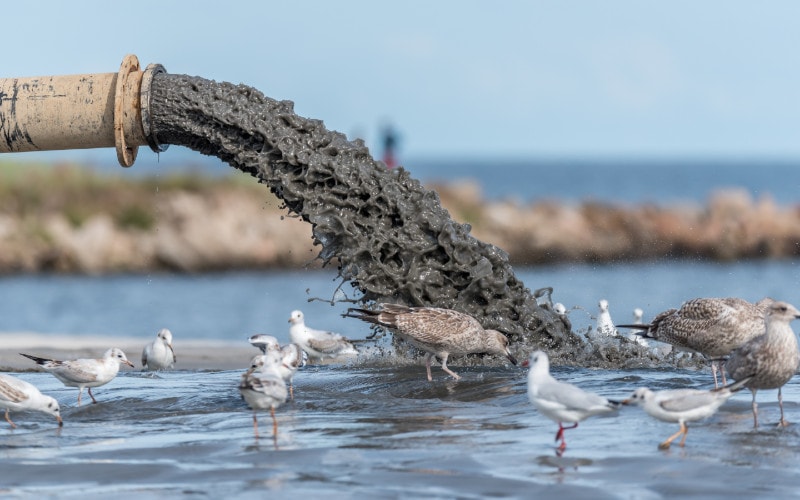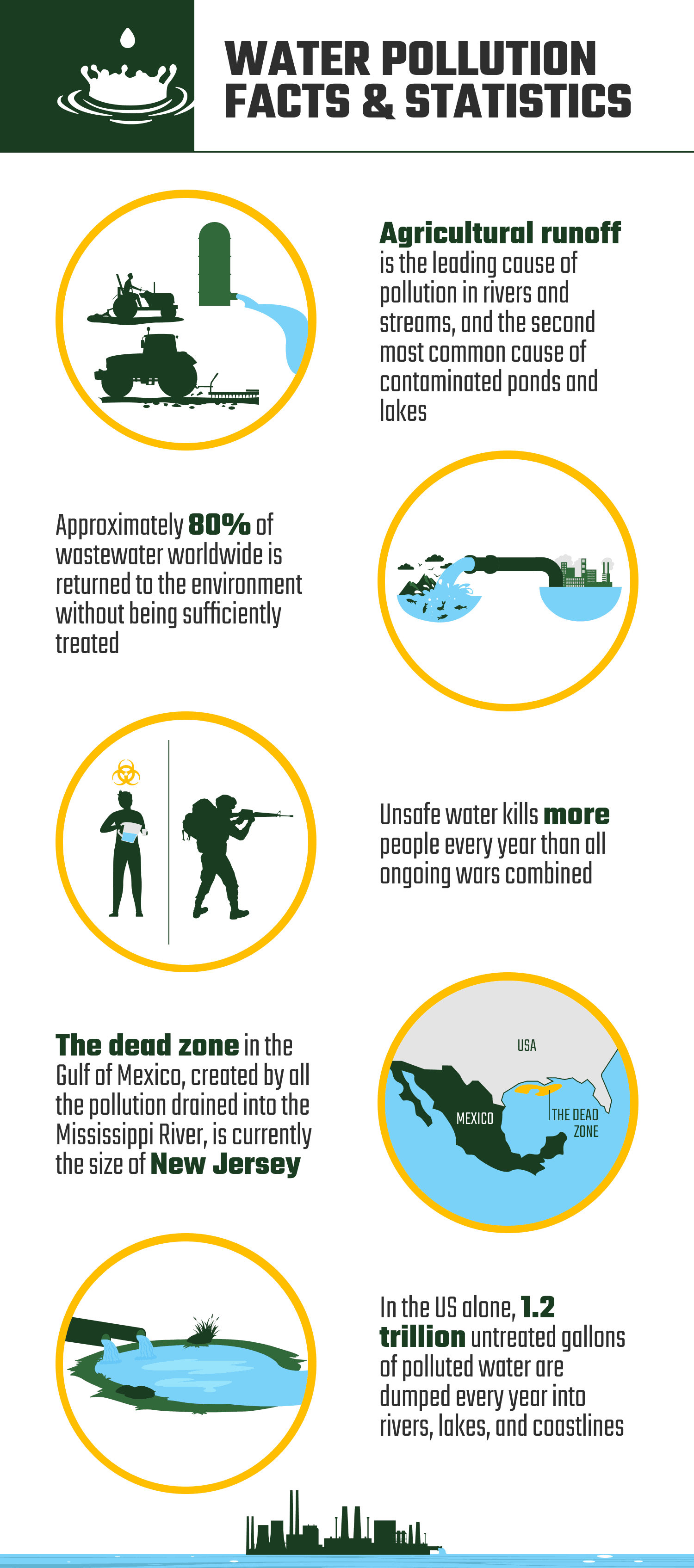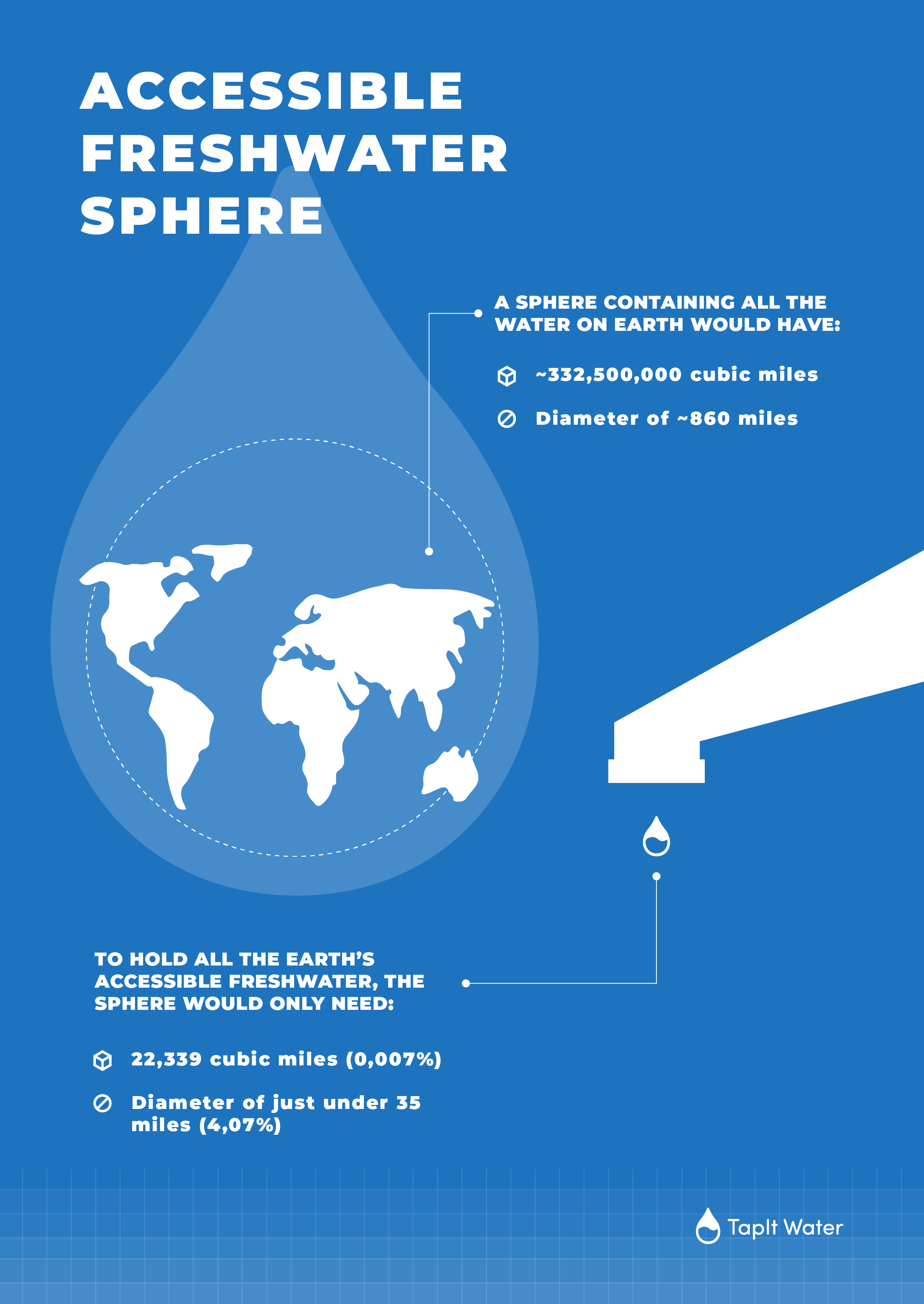15 Interesting Water Pollution Facts & Statistics to Know in 2025
-
Pete Ortiz
- Last updated:

Note: This article’s statistics come from third-party sources and do not represent the opinions of this website.
Water pollution does not receive nearly as much attention in the media as other forms of environmental degradation. Right now, the world’s focus is on climate change — but we shouldn’t forget that other forms of pollution are having real, harmful effects on human life in the modern world.
According to the United Nations, polluted water kills and injures more people every year than war and violence do. The total number of victims is on par with those killed annually by serious diseases like HIV. Nor is the problem confined to the developing world, as the crisis in Flint, Michigan proves.
In this article, we’ve collected some of the most sobering statistics about water pollution. Use these facts to inspire yourself and others to get involved in the ongoing fight for clean water.

Water Pollution Statistics
1. Agricultural runoff is the leading cause of pollution in rivers and streams, and the second most common cause of contaminated ponds and lakes
- Agriculture runoff can result from overworked or overgrazed land, animal waste from feedlots, or indiscriminate use of pesticides and fertilizer.
2. Approximately 80 percent of wastewater is returned to the environment without being sufficiently treated
- Developed nations release around 30 percent of their wastewater without adequate treatment, while low-income countries release up to 92 percent.
3. Harmful algae blooms are the most common way that freshwater becomes contaminated
- Algae take over freshwater through a process called eutrophication. Eutrophication occurs when concentrations of nitrogen or phosphorus increase in a body of water, encouraging uncontrolled plant growth that depletes the water’s oxygen.
- Nitrogen and phosphorus deposits commonly come from agricultural fertilizer or from human or animal waste.
4. Unsafe water kills far more people every year than all ongoing wars combined
5. People in low-income countries are at the highest risk for exposure to polluted water
- Rapid economic growth, coupled with a lack of access to water treatment technology, increases the chance of a person regularly consuming wastewater.
6. In chemistry, water is known as the universal solvent. More liquids and solids, including potential pollutants, dissolve in water than in any other liquid on the planet
7. A sphere containing all the water on Earth would have a volume of around 332,500,000 cubic miles, and a diameter of approximately 860 miles. To hold all the Earth’s accessible freshwater, the sphere would only need a volume of only 22,339 cubic miles, and a diameter of just under 35 miles
- Much of the freshwater on Earth is too far beneath the crust to be reached by humans.

8. In 2012, 35 percent of lakes in the United States suffered from excessive nitrogen pollution, and 40 percent suffered from an excess of phosphorus
9. Water pollution comes in two forms, point source, and nonpoint source. Point source pollution comes from an identifiable location, such as a pipe or a smokestack. Nonpoint source pollution cannot be traced to a source — an example is the runoff from an entire town contaminating the river that drains its watershed
- Nonpoint source pollution is a larger cause of pollution in the United States, since point source pollution is far easier to regulate.
10. The dead zone in the Gulf of Mexico, created by all the pollution drained into the Mississippi River, is currently the size of New Jersey
- Each year, the dead zone is fed with approximately 1.5 million tons of runoff
11. In the US alone, 1.2 trillion untreated gallons of polluted water are dumped every year into rivers, lakes, and coastlines
12. In 2010, 2.5 billion people lived without access to modern sanitation technology, requiring them to defecate in ways that could pollute their water supply. About 70 percent of these people — about 1.8 billion — lived in Asia
13. On average, low-income countries with access to water sanitation display a 3.7 percent increase in economic growth each year
14. The United States has an estimated 20,000 sites where poorly stored hazardous waste could leak into the groundwater supply
(source: Groundwater Foundation)
- Examples of dangerous sites include abandoned mines, underground storage facilities, and unmaintained septic tanks.
15. Outside of the U.S., China is another of the worst-performing large countries in terms of water quality. In 2015, 40 percent of the surface water in Beijing was deemed unfit for human contact of any kind
- 85 percent of the river water in Shanghai was determined to be useless, and 95 percent in the northern city of Tianjin.
What Are the Biggest Causes of Water Pollution?
The foremost causes of water pollution vary depending on what part of the world you’re asking about. However, it almost always comes back to an excess of nitrogen and phosphorus in the water sources.
In low-income nations, as determined by the United Nations Environmental Program, the primary cause of pollution is a lack of access to sanitation technology. People and animals have no choice but to expel their waste in the open. This waste deposits nutrients in the water, leading to unchecked algae blooms that sap the water of its oxygen and make it undrinkable.
As a nation’s economy develops, the main cause of water pollution shifts to unregulated industry and agriculture. According to the CDC, farmers spray pesticides and apply fertilizers in excessive amounts, creating dangerous runoff that seeps into streams, lakes, and groundwater. Meanwhile, industrial waste is often dumped into water sources without being treated.

What are the Effects of Water Pollution?
According to the UN’s water program, polluted water vastly increases an individual’s risk of contracting a potentially fatal disease. Cholera, polio, typhoid fever, and other dangerous infections are known to be waterborne, and live and breed in water contaminated with human and animal waste.
The effects of poorly sanitized water can be seen in a country’s broad economic trends. Research for World Water Day 2010 revealed that access to decent water treatment can spur a developing country’s economy to grow an average of 3.7% faster.

Access to Clean Water Facts and Statistics
A World Health Organization fact sheet, compiled in 2019, found that only 7 out of every 10 humans has a source of safe, on-demand drinking water in or near their home. A further 2 of every 10 has access to an improved water source within a 30-minute round trip. Lastly, 1 in 10 people — about 785 million — have no access to safe drinking water whatsoever.
The WHO estimates that if the current population and climatic trends hold, 50% of people will live in water-stressed areas by 2025.
In Conclusion
The news about water pollution is not all bleak. Regulations such as the U.S. Clean Water Act of 1972 have proven effective at cleaning up formerly unusable rivers. We should also take heart from the cleanup efforts of scientists and entrepreneurs like Boyan Slat, who has deployed fleets of ships to gather microplastics from the ocean and dispose of them safely.
The fight for clean water is ongoing and affects everybody on the planet. The most important thing you can do to help is to get active in passing large-scale regulations to protect vulnerable water sources. Nothing you can do is too small!
Featured Image Credit: JonShore, Shutterstock
Contents





